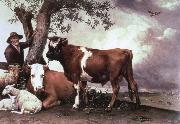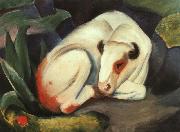
Oil On
Canvas, Real Flavor of Old Masters
|
Franz Marc
|
|||
|
|
|||
| 1880-1916 German Franz Marc Locations Franz Marc was born in 1880, in the German town of Munich. His father, Wilhelm, was a professional landscape painter, and his mother Sophie was a strict Calvinist. He began study at the Academy of Fine Arts, Munich in 1900. In 1903 and 1907 he spent time in Paris and discovered a strong affinity for the work of Vincent van Gogh. Marc developed an important friendship with the artist August Macke in 1910. In 1911 he formed the Der Blaue Reiter artist circle with Macke, Wassily Kandinsky, and other artists who decided to split off from the Neue K??nstlervereinigung movement. He showed several of his works in the first Der Blaue Reiter exhibition at the Thannhauser Galleries in Munich between December 1911 and January 1912. The exhibition was the apex of the German expressionist movement and also showed in Berlin, Köln, Hagen, and Frankfurt. In 1912, Marc also met Robert Delaunay, whose use of color and futurist method was a major influence on Marc's work. Marc became influenced by futurism and cubism, and his art became stark and abstract in nature. His name was on a list of notable artists to be withdrawn from combat in World War I. Before the orders were carried out, he was struck in the head and killed instantly by a shell splinter during the Battle of Verdun (1916). | |||
|
|
|||
|
|
The Bull Franz Marc12.jpg Painting ID:: 2745 Visit European Gallery |
1911 Solomon R Guggenheim Museum, New York | |
Height Width |
INS/CM |
||
|
X |
|
||
|
|
|||
|
POTTER, Paulus
|
|||
|
|
|||
| Dutch Baroque Era Painter, 1625-1654 Son of Pieter Potter. He was related through his mother, Aechtie Pouwels (d 1636), to the wealthy and powerful von Egmont and Semeyns families, who held important offices in Enkhuizen and at the court in The Hague. He worked in his father's studio in Amsterdam during the 1630s and, like him, painted history subjects that show the strong influence of Claes Moeyaert, with whom Paulus may also have studied. In the painting Abraham Returning from Canaan he adapted the landscape setting from an etching by Moses van Uyttenbroeck and the figures from works by Moeyaert from over ten years earlier. Significantly, however, he redistributed the numerous animals and figures that Moeyaert had aligned evenly across the frontal plane; Potter placed them to one side, permitting a view into the deep distance where other animals can be seen. Potter followed his father more than Moeyaert in searching for ways to integrate his figures with the landscape, | |||
|
|
|||
|
|
the bull new20/POTTER, Paulus-558995.jpg Painting ID:: 56077 Visit European Gallery |
1647,oil on canvas,92.75x113.375 in,235.5x339 cm,mauritshuis,the hague,netherlands | |
Height Width |
INS/CM |
||
|
X |
|
||
|
|
|||
|
Franz Marc
|
|||
|
|
|||
| 1880-1916 German Franz Marc Locations Franz Marc was born in 1880, in the German town of Munich. His father, Wilhelm, was a professional landscape painter, and his mother Sophie was a strict Calvinist. He began study at the Academy of Fine Arts, Munich in 1900. In 1903 and 1907 he spent time in Paris and discovered a strong affinity for the work of Vincent van Gogh. Marc developed an important friendship with the artist August Macke in 1910. In 1911 he formed the Der Blaue Reiter artist circle with Macke, Wassily Kandinsky, and other artists who decided to split off from the Neue K??nstlervereinigung movement. He showed several of his works in the first Der Blaue Reiter exhibition at the Thannhauser Galleries in Munich between December 1911 and January 1912. The exhibition was the apex of the German expressionist movement and also showed in Berlin, Köln, Hagen, and Frankfurt. In 1912, Marc also met Robert Delaunay, whose use of color and futurist method was a major influence on Marc's work. Marc became influenced by futurism and cubism, and his art became stark and abstract in nature. His name was on a list of notable artists to be withdrawn from combat in World War I. Before the orders were carried out, he was struck in the head and killed instantly by a shell splinter during the Battle of Verdun (1916). | |||
|
|
|||
|
|
The Bull new24/Franz Marc-474544.jpg Painting ID:: 77823 Visit European Gallery |
The Bull (Der Stier), oil on canvas, Solomon R. Guggenheim Museum, New York. cjr | |
Height Width |
INS/CM |
||
|
X |
|
||
|
|
|||
|
Franz Marc
|
|||
|
|
|||
| 1880-1916 German Franz Marc Locations Franz Marc was born in 1880, in the German town of Munich. His father, Wilhelm, was a professional landscape painter, and his mother Sophie was a strict Calvinist. He began study at the Academy of Fine Arts, Munich in 1900. In 1903 and 1907 he spent time in Paris and discovered a strong affinity for the work of Vincent van Gogh. Marc developed an important friendship with the artist August Macke in 1910. In 1911 he formed the Der Blaue Reiter artist circle with Macke, Wassily Kandinsky, and other artists who decided to split off from the Neue K??nstlervereinigung movement. He showed several of his works in the first Der Blaue Reiter exhibition at the Thannhauser Galleries in Munich between December 1911 and January 1912. The exhibition was the apex of the German expressionist movement and also showed in Berlin, Köln, Hagen, and Frankfurt. In 1912, Marc also met Robert Delaunay, whose use of color and futurist method was a major influence on Marc's work. Marc became influenced by futurism and cubism, and his art became stark and abstract in nature. His name was on a list of notable artists to be withdrawn from combat in World War I. Before the orders were carried out, he was struck in the head and killed instantly by a shell splinter during the Battle of Verdun (1916). | |||
|
|
|||
|
|
The Bull new24/Franz Marc-926696.jpg Painting ID:: 81099 Visit European Gallery |
oil on canvas, Solomon R. Guggenheim Museum, New York. Date 1911(1911) cyf | |
Height Width |
INS/CM |
||
|
X |
|
||
|
|
|||










